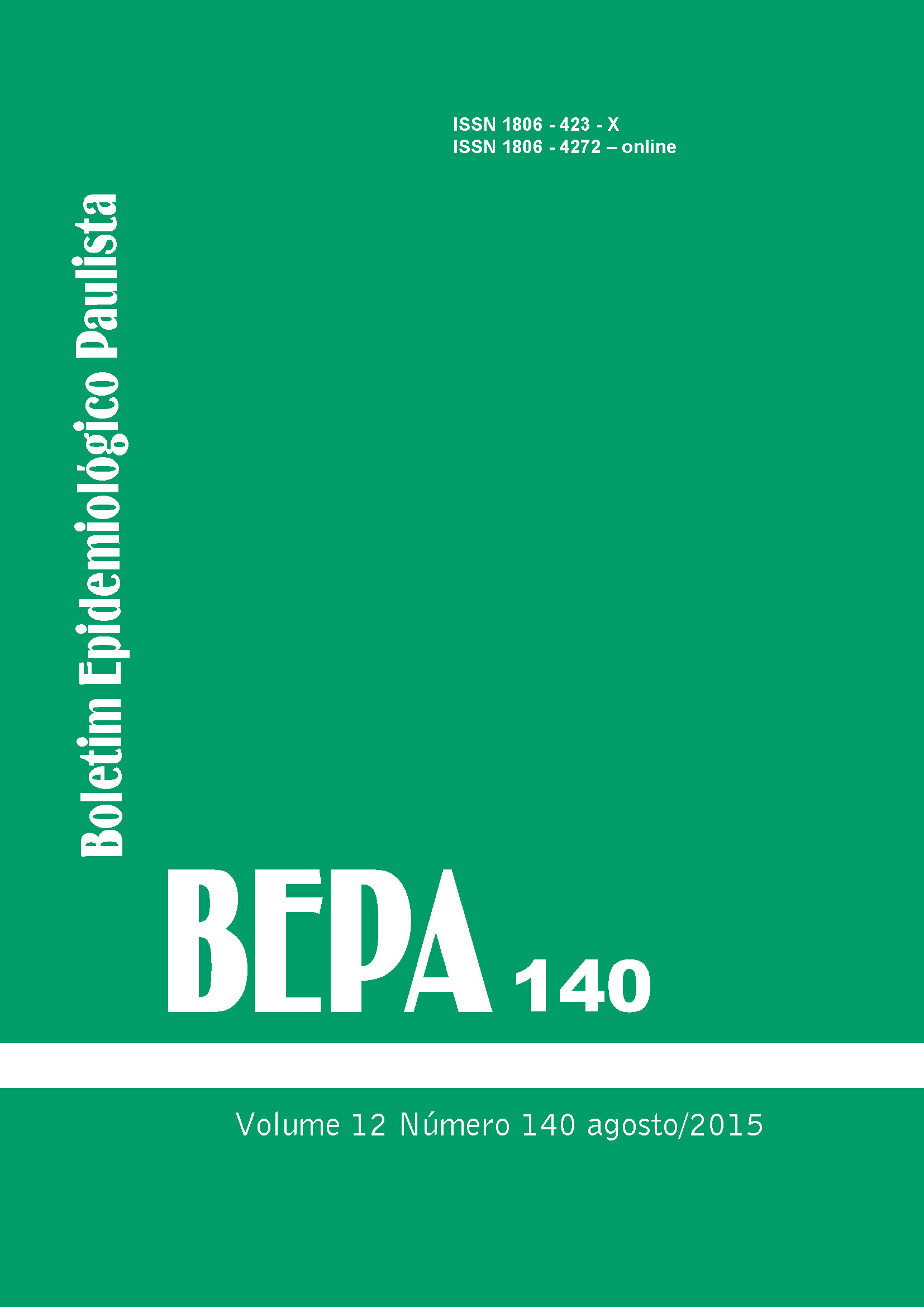Resumo
Introdução: as drogas anti-TNF (inibidoras do fator de necrose tumoral), usadas para tratar doenças autoimunes, podem aumentar o risco de reativação de infecções latentes, como tuberculose e outras infecções bacterianas e fúngicas. Objetivo: identificar os casos de tuberculose diagnosticados em pacientes que fizeram uso de anti-TNF, no período de 2006 a 2010. Métodos: Foi realizado um estudo retrospectivo e descritivo. A partir de uma lista de APACs (Autorização para Procedimentos de Alta Complexidade) de pacientes em uso de anti-TNF, fornecida pela Secretaria de Estado da Saúde – SP, fez-se busca na base de dados do TBweb (Sistema de Notificação e Acompanhamento dos Casos de Tuberculose), para identificar possíveis casos de tuberculose. Utilizou-se o software RecLink III, que implementa a técnica de relacionamento probabilístico de registros. Resultados: Dos 10.631 pacientes usuários de anti-TNF, foram identificados 57 casos de tuberculose notificados ao TBweb, cujo banco continha 76.079 registros. Os pacientes que apresentaram tuberculose depois do uso do anti-TNF foram 40, resultando em um coeficiente de incidência de 375,5 casos/100.000 pacientes em uso da droga; 9,6 vezes maior que o da população geral, de 39,2 casos/100.000 habitantes. Conclusão: Apesar das limitações do estudo, decorrentes do fato de se trabalhar com dados secundários, verificou-se aumento da incidência de tuberculose entre os pacientes submetidos ao tratamento com drogas anti-TNF, justificando-se a adoção de estratégias visando à prevenção da tuberculose e acompanhamento dos pacientes em tratamento com essas drogas.
Referências
Farga V, Caminero JA. Tuberculosis. In: Farga V, Caminero JA. Historia Natural de la tuberculosis en el ser humano. Etiopatogenia. Santiago de Chile: Editorial Mediterráneo. 2011; p. 27-44.
Andrade Junior DR, Santos AS, Castro I, Andrade DR. Correlation between serum tumor necrosis factor alpha levels and clinical severity of tuberculosis. Braz J Infect Dis. 2008;12(3):226-33
Vitale RF, Ribeiro FAQ. O papel do fator de necrose tumoral alfa (TNF-α) no processo de erosão óssea presente no colesteatoma adquirido da orelha média. Rev Bras Otorrinolaringol. 2007;73(1):123-7.
Wallis R. Infectious complications of tumor necrosis factor blockade. Curr Opin Infect Dis. 2009; 22: 403-9.
Schachna L. The anti-TNF revolution in ankylosing spondylitis. Med J Aust. 2004;181(10):529-30.
Bray M G, Poulain C, Dougados M, Gossec L. Frequency and tolerance of antituberculosis treatment according to national guidelines for prevention of risk of tuberculosis due to tumor necrosis fator blocker treatment. Joint Bone Spine. 2010;77(2):135-41.
Pereira I A et al. Consenso 2012 da Sociedade Brasileira de Reumatologia para o tratamento da artrite reumatoide. Rev Bras Reumatol. 2012; 52(2): 135-74.
Silva LC1, Geluk A, Arnone M, Romiti R, Franken KC, Duarte AJ, Takahashi MD, Benard G. Infliximab partially impairs the anti-Mycobacterium tuberculosis immune responses of severe psoriasis patients with positive tuberculin skin-test. J Eur Acad Dermatol Venereol. 2012;26(3):319-24.
Miller EA, Ernst JD. Anti-TNF immunotherapy and tuberculosis reactivation: another mechanism revealed. J Clin Invest. 2009;119(5): 1079-82.
Gómez-Reino JJ, Carmona L, Descalzo M. Risk of tuberculosis in patients treated with tumor necrosis fator antagonists due to incomplete prevention of reactivation of latente infection. Arthritis Rheum. 2007; 57(5): 756-61.
Murdaca G, Colombo BM, Puppo F. Anti-TNF-alpha inhibitors: a new therapeutic approach for inflammatory immunemediated diseases: an update upon efficacy and adverse events. Int J Immunopathol Pharmacol. 2009; 22(3): 557-65.
Camargo Jr KR.; Coeli CM. Reclink: Aplicativo para o relacionamento de banco de dados implementando o método probabilistic record linkage. Cadernos de Saúde Pública. 2000; Rio de Janeiro, 16(2): 439-47.
Carmona L, Gómez-Reino JJ, Rodríguez- Valverde V, Pascual-Gómez DME, Mola EM, Carreño L, Figueroa M and BIOBADASER Group Effectiveness of recomendations to prevent reactivation of latente tuberculosis infection in patients treated with tumor necrosis fator antagonists. Arthritis Rheum. 2005; 52(6): 1766-72.
BiobadaBrasil. Registro da sociedade e dos reumatologistas brasileiros. Editorial. Rev Bras Reumatol. 2011; 51(2): 109-12.
BiobadaBrasil. Registro brasileiro de monitorização de terapias biológicas em doenças reumáticas. Disponível em http:// biobadaser.ser.es/biobadamerica/ Brasil/ cgi-in/upload/archivo.aspx?id=10
Farga V, Caminero JA. Tuberculosis. In: Farga V, Caminero JA. Historia Natural de la tuberculosis en la comunidad. Epidemiología. Santiago de Chile: Editorial Mediterráneo. 2011.p. 56-82.
Solovic I et al. The risk of tuberculosis related to tumour necrosis factor antagonist therapies: a TBNET consensus statement. Eur Respir J. 2010;36(5):1185-206.
Ministério da Saúde. Secretaria de Vigilância em Saúde. Manual de Recomendações para o Controle da Tuberculose no Brasil. Brasília (DF). 2011.

Este trabalho está licenciado sob uma licença Creative Commons Attribution 4.0 International License.
Copyright (c) 2015 Vera Maria Neder Galesi, Edméa Costa Pereira, Regina Maura Cabral de Melo Abrahão, Péricles Alves Nogueira
